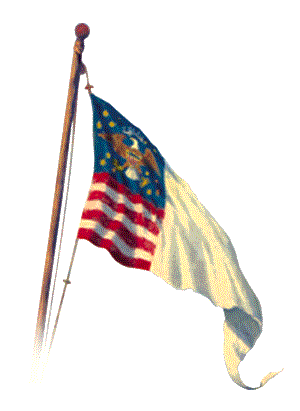

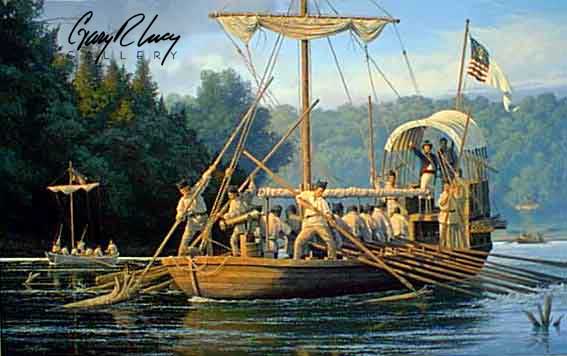
Of all the extended research that I have been doing concerning the subject of Lewis and Clark, the research involving the flag flown from the keelboat has been the most interesting. The research and depiction of the crew members, the keelboat, uniforms, pirogues, and landscapes have been tedious; however, the flag image I have created was the most laborious issue. In the following essay, I would like to explain the reasons that formulate my interpretation of the keelboat flag and how I could make no other decision based on the facts as I found them.
There have been many attempts to interpret this flag by various respected historic groups. However, I believe, with respect to my friends in the historic community of differing opinion, the image I will outline is the most plausible explanation.
I would like to list my reasons
for depicting the flag flown from the stern of the keelboat as
an expedition flag approximately twelve to fourteen feet in length
and fabricated by taking a portion of an Indian Presentation Flag
and adding a white pennant. I will examine the keelboat drawings
of William Clark to evaluate his techniques and instruments used
to produce the images. As an artist, I will give my impression
of what Clark is trying to convey to the viewer through his drawings
of the keelboat. I will list the known flags of the period and
explain why I feel an Indian Presentation Flag of that period
with an Eagle in the canton area is the only choice for the flag
used in the fabrication process.
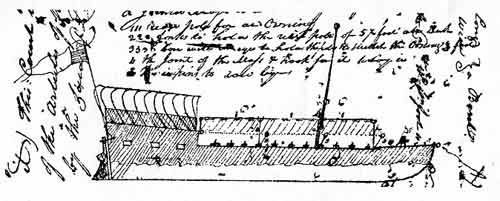

The above drawings, made at the Wood River encampment in the winter of 1803-04, were taken from the Lewis and Clark Journals. These were the only drawings made of the keelboat. We see a detailed drawing outlining the structure of the boat; and, in addition, we find a detailed drawing of the flag Clark is telling us flew from the stern of the boat. I can surmise no other conclusion from the drawing other than Clark is telling us that he is detailing the keelboat as it would have appeared on the journey. If we are to believe the journals, we must interpret this drawing as accurate.
The flag we see in the drawing is not like any other flag of the period. Lewis and Clark's flag appears to be an expedition flag. A flag fabricated specifically for the expedition. Thus, I feel that an existing flag of that period would have been used and a portion of the stripes would have been cut from the flag along side the canton area. The canton area of our American Flag is the field of blue. A white pennant, representing the expedition came in peace, would have been added. Based on the assumption that the keelboat was fifty-five feet in length at the water line, it can be mathematically surmised from the profile drawing that the flag would have been forty-eight to fifty-four inches high and twelve to fourteen feet in length. With this thought in mind, let us begin to examine the images more closely.
In the following images,
figures 1 and 2, I have isolated Clark's drawings of the pennant
style flag. Please note that at the time of my first contact with
the drawings of Clark I had not had direct access to the drawings
in the original journals. Thus, I have had to rely on copies of
Clark's drawings. As the images were copied and enlarged, the
quality has been compromised. I removed the image in the canton
area of the flags from my first copies, see figures 3 and 4, and
replaced the dots Clark made on his drawing in their original
location, figures 1 and 2, using a better image of the original.
Also, in figures 3 and 4 it is difficult to determine the number
of stripes below the canton area. However, from careful examination
of better images, I have found the following to be the true number
of dots and stripes. In figure 1, we see a flag with a random
display of 11 dots and 7 stripes. In figure 2, we see a flag with
a random display of 7 dots and 6 stripes.
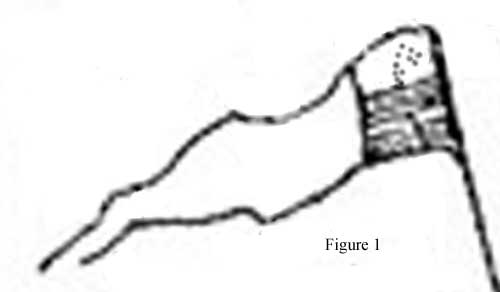
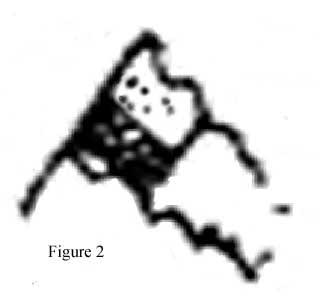
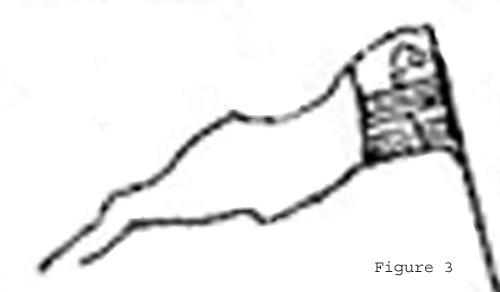
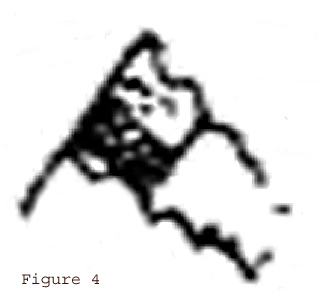
Once again, at the time of this writing I have not been able to produce a better image of the original. On first glance, one would be tempted to declare that the dots shown in figures 1 and 2 are stars. I have included figures 3 and 4 because these were the first images of the Clark drawings I saw, poor copies. When I first reviewed the poor copies, my thought was that Clark was not depicting stars here. He is depicting an image. The Missouri Historical Society in St. Louis has produced an outstanding exhibit dealing with Lewis and Clark. Among the artifacts exhibited is an exact reproduction of Clark's keelboat drawings. This image displays the distinct dot pattern, thus, reinforcing the existence of the dots and their placement. However, my idea of an image in this canton area is still my predominate feeling.
Clark is using
a quill pen and ink for these renderings. The images are small;
and, upon close examination of the document produced by the Missouri
Historical Society, I find the canton area of the flags shown
above is no more than a one eighth-inch square. The delineation
of any type of complicated detail would be extremely difficult
if not impossible to achieve with tools available. The last area
Clark would have drawn while detailing his rendering of the keelboat,
in my opinion as an artist, would have been the flag. Thus, the
flag was his last thought here; and, in my opinion, he is using
a dotting technique to tell us that there is an image in the canton.
I know this is done because I do it all the time in tiny areas
when I do not want to run the risk of messing up the more important
portions of the drawing. At the time he is making the drawing,
Clark may not have been concerned about the flag. The image of
the flag may be secondary to the image of the boat; thus, assuming
that everyone knows that there is an image in this location of
the flag. His goal appears to be an accurate depiction of the
boat to figure the square footage for sleeping and lockers. If
my theory is correct, we are looking at an image in the canton
area. What is that image?
It was not uncommon for the flag at that time to be altered by cutting or writing on it to fit an occasion. My observations lead me to conclude that a flag of the period was altered to produce the Lewis and Clark expedition flag. What flag would have been altered? I have three possible suggestions:
1) The Betsy Ross American Flag of 1776 with a circle pattern
of stars.
2) The American Flag of 1804.
3) An Indian presentation flag with an eagle in the canton area.
1. The Betsy Ross American Flag of 1776 with a circle pattern
of stars.
Because Clark's drawings may, at first glance, appear to be exhibiting
a circular star pattern, some efforts have been made to use a
circular pattern in the pennant flag; however, I cannot accept
that Lewis and Clark would be using a flag from the 1776 - 1794
time period. The flag act of 1794 clearly states that the flag
will contain 15 stars and 15 stripes. These stars appear in 5
rows with 3 stars per row in the canton area. There was another
flag with 12 stars in a circle and one star in the center, the
Cowpens Flag of 1781; however, this flag was not used universally
and only on a regional basis. Lewis and Clark were official government
representatives. To think they would be using a flag design outdated
for ten years is not reasonable in my opinion. To my knowledge,
no other flags used by the Army, of which Lewis and Clark were
commissioned officers, exhibited stars in a circular pattern.
Therefore the 1776 flag appears to be the only basis for this
premise.
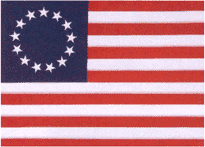
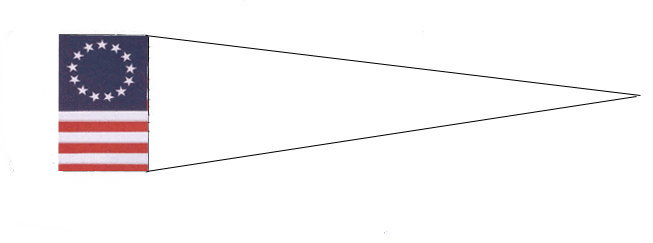
2. The American Flag of 1804.
Because of the location of the dots, I feel that this flag can be discounted without further study. Clark's dotting pattern is random, see figures 1 and 2. The pattern exhibited by the 1804 flag would have been easy to duplicate even in this small area because of its regular pattern. This would have been easy for Clark to render. He did not. Therefore, I am discounting this possibly as well.

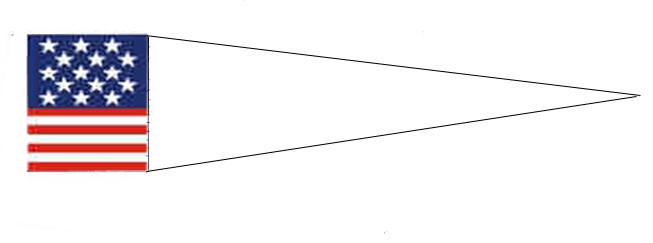
3. An Indian Presentation Flag with an Eagle in the canton area.
This possibility seems to be the only plausible solution to the problem. Let us examine this flag. Indian Presentation Flags were designed to be given to the chiefs of individual Indian nations. Lewis and Clark carried several of these flags with them and gave them as gifts to the tribal leaders. The unique feature of the flag was the Eagle in the canton area of the flag. Several Indian Presentation Flags have been documented. Note the two examples below. The first, shown below to the left, is an Indian Presentation Flag dating to the 1790's time period and given to an Indian Chief by General George Rodgers Clark. The flag has been in a Native-American family for seven generations. The flag has thirteen stripes and an arch of thirteen stars. An Eagle can be found in the canton area. The second is an Indian Presentation Flag, shown below, in the collection of the Chicago Historical Society dated to the 1808 time period. This flag most closely resembles the image I am portraying in my interpretation of the expedition flag. The flag has fifteen stripes and fifteen gold six point stars and an Eagle in the canton area. The stars and Eagle are painted in the canton area. The flag measures 58 inches by 150 inches. Thus, the 58-inch measurement is very close to the mathematical calculation taken from the Clark drawings pertaining to the possible size of the expedition flag.
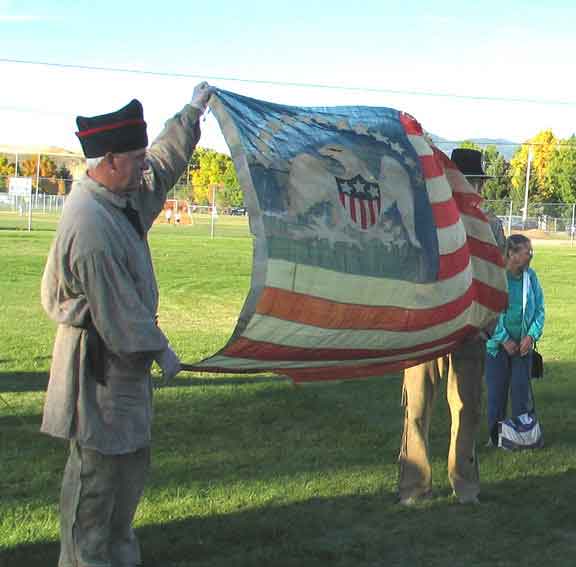
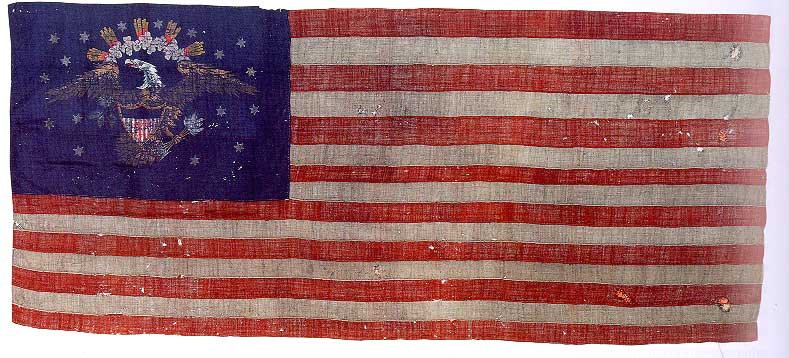
Of the few
documented Indian Presentation Flags, the one consistent symbol
contained in the flag is the Eagle. I have used the two flags
above because they bracket the time period of Lewis and Clark.
The Eagle is not only a national symbol contained in our coat
of arms and a symbol of the presidency directing the expedition;
but, for Lewis and Clark this symbol constantly recurs as an image
on buckles, gorgets, buttons, cockade pins, and sword handles
to mention a few. To deduce that they would include an image of
an Eagle in their expedition flag is a logical deduction. The
Eagle would have also been included in the Indian Presentation
Flag and in the expedition flag because to the Native-Americans
the Eagle was a sacred symbol. Thus, the image I have interpreted
as the expedition flag is the most logical choice. The white banner
added to the Indian Presentation Flag would represent the fact
that the Lewis and Clark expedition wished to be seen as coming
in peace. The addition of the Eagle in the canton area represents
not only the government of the United States of America but reinforces
our respect for the symbols held in the highest regard by the
Native-Americans.
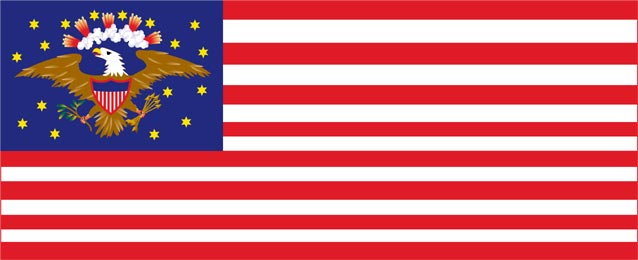
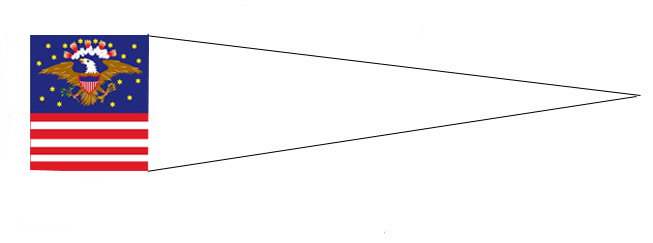
In the following comparison drawings, I have removed all unrelated markings from Clark's drawings and in the case of the top drawing reversed the image to correspond to my flag drawing on the left. Clark's drawings were taken from figures 3 and 4 above. These images seem to connect the dots, pardon the pun, to better display the image of an Eagle that I see in Clark's drawing.
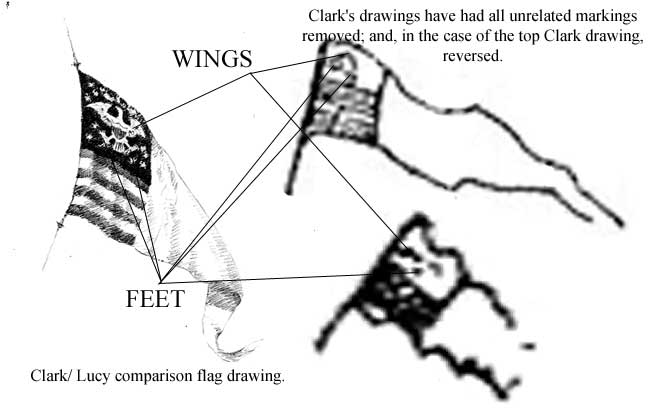
My work with historic interpretation has been very rewarding. It appears that I will continue to work using history as a subject in some capacity for the remainder of my career. The rivers will also continue to be a venue of creative efforts. I have been working with the subject of the river for almost twenty years. On, September 3, 2004 I will open a showing of my work with the Jefferson National Expansion Memorial. The Old Courthouse Museum in downtown St. Louis will house over ninety of my original paintings dealing with the history of the rivers entitled Inland Waterways: The Highways of Our Heritage. The show will run through January 12, 2005. I hope you will be able to attend.
Respectfully submitted,
Copyright, Gary R. Lucy, 2004
Return to: